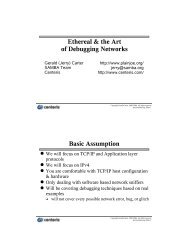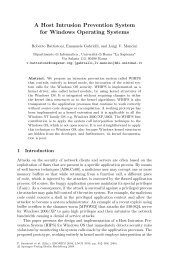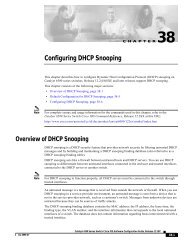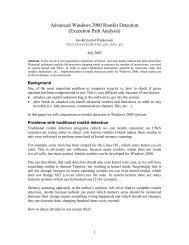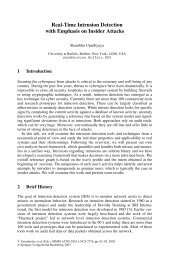ICSA Labs 10th Annual Virus Prevalence Survey 2004.pdf - Craig ...
ICSA Labs 10th Annual Virus Prevalence Survey 2004.pdf - Craig ...
ICSA Labs 10th Annual Virus Prevalence Survey 2004.pdf - Craig ...
- No tags were found...
You also want an ePaper? Increase the reach of your titles
YUMPU automatically turns print PDFs into web optimized ePapers that Google loves.
<strong>ICSA</strong> <strong>Labs</strong> <strong>Virus</strong> <strong>Prevalence</strong> <strong>Survey</strong> 2004data and systems, and costing more than in past years. All of this, despite increases in theiruse of anti-virus products, improved updating and upgrading, and better management of anti-virussystems. Corporations are spending more time, energy, and dollars in purchasing, installing,and maintaining anti-virus products without achieving their desired results.Part of the reason for the increased cost of viruses is the impact they have on the businessfunctions of a company. In years past, viruses were nuisances and caused little real damage.Those days are long past. Today’s viruses continue to escalate in all those areas that affectthe function of organizations. Loss of productivity is by far the most important consequenceof both virus encounters and disasters. At least 50 percent of the respondents list Loss ofproductivity, PC unavailable, Corrupted files, and Loss of access to data as the primary effectthat viruses had on their organizations.The “threatscape” for viruses and worms has shifted toward multifaceted and faster spreadingattacks and infection mechanisms. With this shift comes the importance of mitigating the riskof new and previously unknown viruses. Even though the current reactive anti-virustechnologies are much faster at providing updates for known viruses, and their heuristicshave improved greatly, known virus scanning is only a baseline. Corporations also need tolook toward other proactive protection strategies such as better and finer grained heuristics,access controls, behavior blocking, change detection, filtering, and other generic technologies.PROTECTION STRATEGIES:Again, our survey reports that anti-virus product usage is up at every level from previousyears. Only firewalls and proxy servers show less than a 90 percent usage of anti-virusproducts. More than 95 percent of users report that desktop, server, and email gateway serverusage has at least 90 percent coverage. Yet, with anti-virus product usage up, why do wecontinue to see the increases in infections, disasters, and costs?Very simply, we must begin to think differently about virus and malware protection. Antivirusproducts are and will remain an important part of the virus protection equation, but theyare only a part of the solution. It is no longer enough to think of virus protection in terms ofreactive technology. The example given above showing the increasing rapidity of viruses beingspread is evidence that the use of anti-virus products, while necessary, is not enough.Corporations need to adopt more proactive and holistic protection philosophy that includesstrong leadership, a comprehensive security policy, and intelligent risk management. <strong>ICSA</strong><strong>Labs</strong> and Cybertrust have recommended email gateway filtering and generic virus controlsand procedures since 1997. In the last three years we have seen a significant increase in theuse of perimeter anti-virus products. However, corporations are still slow in adopting genericprotection schemes. Generic controls exist that can be employed with minimal maintenanceand manageable infringement on corporate business practices. For a number of years,Cybertrust has published a list of these generic controls in its anti-virus policy guide.These controls include such protections as file attachment filtering; specific configuration forvarious email clients, email servers, web browsers, and business applications such as wordprocessors and spreadsheets; and various other controls that are generally easy to implement,require infrequent updates, and go unnoticed by the average user because of theirCopyright 2005 <strong>ICSA</strong> <strong>Labs</strong>, a division of Cybertrust, Inc. All Rights Reserved.This information may not be incorporated into any other work and may be reproduced only with the express written permission of Cybertrust, Inc.Page 25



